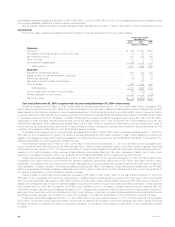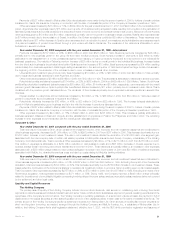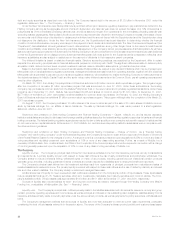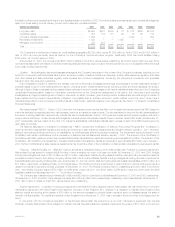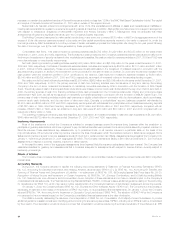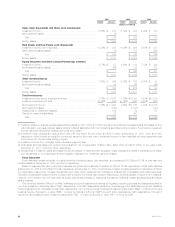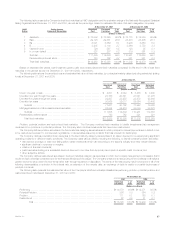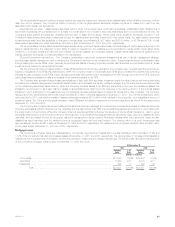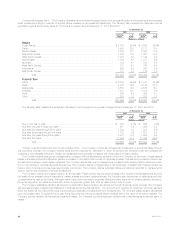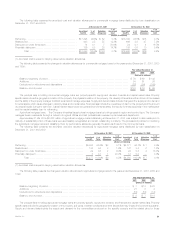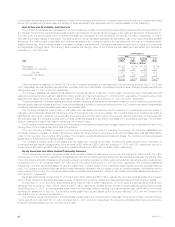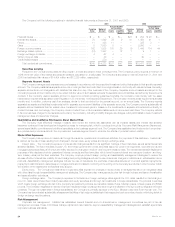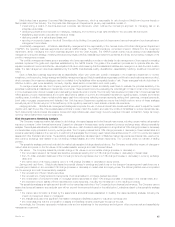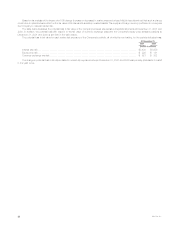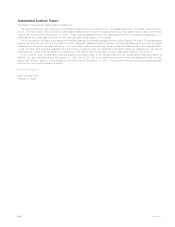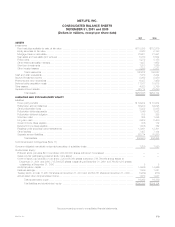MetLife 2001 Annual Report Download - page 32
Download and view the complete annual report
Please find page 32 of the 2001 MetLife annual report below. You can navigate through the pages in the report by either clicking on the pages listed below, or by using the keyword search tool below to find specific information within the annual report.
The principal risks inherent in holding mortgage-backed securities are prepayment, extension and collateral risks, which will affect the timing of when
cash flow will be received. The Company’s active monitoring of its mortgage-backed securities mitigates exposure to losses from cash flow risk
associated with interest rate fluctuations.
Asset-backed securities. Asset-backed securities, which include home equity loans, credit card receivables, collateralized debt obligations and
automobile receivables, are purchased both to diversify the overall risks of the Company’s fixed maturities assets and to provide attractive returns. The
Company’s asset-backed securities are diversified both by type of asset and by issuer. Home equity loans constitute the largest exposure in the
Company’s asset-backed securities investments. Except for asset-backed securities backed by home equity loans, the asset-backed securities
investments generally have little sensitivity to changes in interest rates. Approximately $3,427 million and $3,149 million, or 42.1% and 40.1%, of total
asset-backed securities were rated Aaa/AAA by Moody’s or S&P at December 31, 2001 and 2000, respectively.
The principal risks in holding asset-backed securities are structural, credit and capital market risks. Structural risks include the security’s priority in the
issuer’s capital structure, the adequacy of and ability to realize proceeds from the collateral and the potential for prepayments. Credit risks include
consumer or corporate credits such as credit card holders, equipment lessees, and corporate obligors. Capital market risks include the general level of
interest rates and the liquidity for these securities in the marketplace.
Structured investment transactions. The Company participates in structured investment transactions as part of its risk management strategy,
including asset liability management, and to enhance the Company’s total return on its investment portfolio. These investments are predominately made
through bankruptcy-remote SPEs, which generally acquire financial assets, including corporate equities, debt securities and purchased options. These
investments are referred to as beneficial interests.
The Company’s exposure to losses related to these SPEs is limited to its carrying value since the Company has not guaranteed the performance,
liquidity or obligations of the SPEs. As prescribed by GAAP, the Company does not consolidate such SPEs since unrelated third parties hold controlling
interests through ownership of the SPEs’ equity, representing at least three percent of the total assets of the SPE throughout the life of the SPE, and such
equity class has the substantive risks and rewards of the residual interests in the SPE.
The Company also sponsors financial asset securitizations of high yield debt securities, investment grade bonds and structured finance securities
and also is the collateral manager and a beneficial interest holder in such transactions. As the collateral manager, the Company earns a management fee
on the outstanding securitized asset balance. When the Company transfers assets to an SPE and surrenders control over the transferred assets, the
transaction is accounted for as a sale. Gains or losses on securitizations are determined with reference to the carrying amount of the financial assets
transferred, which is allocated to the assets sold and the beneficial interests retained based on relative fair values at the date of transfer. The Company
has sponsored four securitizations with a total of approximately $1.5 billion in financial assets as of December 31, 2001. Two of these transactions, which
were executed in 2001, included the transfer of assets totaling approximately $289 million which resulted in the recognition of an insignificant amount of
investment gains. The Company’s beneficial interests in these SPEs and the related investment income were insignificant as of and for the years ended
December 31, 2001 and 2000.
The Company also invests in structured investment transactions which are managed and controlled by unrelated third parties. In instances where the
Company exercises significant influence over the operating and financial policies of an SPE, the beneficial interests are accounted for in accordance with
the equity method of accounting. Where the Company does not exercise significant influence, the structure of the beneficial interests (i.e., debt or equity
securities) determines the method of accounting for the investment. Such beneficial interests generally are structured notes, which are classified as fixed
maturities, and the related income is recognized using the retrospective interest method. Beneficial interests other than structured notes are also
classified as fixed maturities, and the related income is recognized using the level yield method. The carrying value of all such investments was
approximately $1.6 billion and $1.3 billion at December 31, 2001 and 2000, respectively. The related income recognized was $44 million and $62 million
for the years ended December 31, 2001 and 2000, respectively.
Mortgage Loans
The Company’s mortgage loans are collateralized by commercial, agricultural and residential properties. Mortgage loans comprised 13.9% and
13.7% of the Company’s total cash and invested assets at December 31, 2001 and 2000, respectively. The carrying value of mortgage loans is stated at
original cost net of prepayments, amortization of premiums, accretion of discounts and valuation allowances. The following table shows the carrying value
of the Company’s mortgage loans by type at December 31, 2001 and 2000:
At December 31,
2001 2000
Carrying % of Carrying % of
Value Total Value Total
(Dollars in millions)
Commercial ********************************************************************* $17,959 76.0% $16,869 76.8%
Agricultural ********************************************************************** 5,268 22.3 4,973 22.7
Residential ********************************************************************** 394 1.7 109 0.5
Total ******************************************************************* $23,621 100.0% $21,951 100.0%
MetLife, Inc. 29



